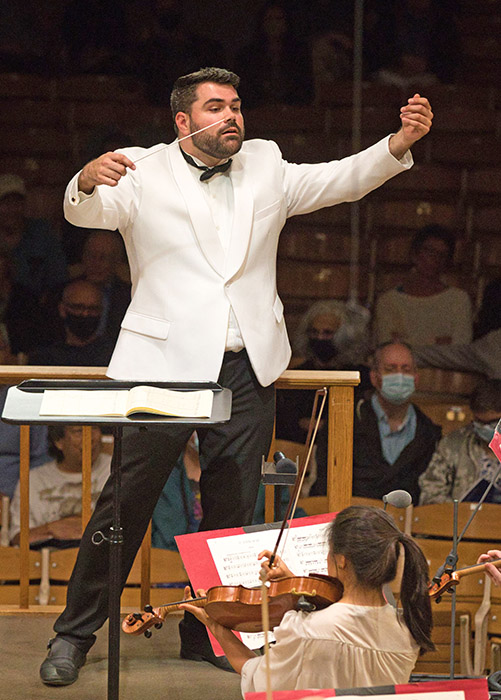

One of the consistent pleasures of the Tanglewood Music Center Orchestra’s Monday evenings has been the presence of new or unfamiliar pieces along with favorites. William Grant Still’s Darker America, though far from new, was the rarity on August 2nd. Fauré and Sibelius are familiar, even though the Sibelius Symphony No. 3 is not among the most frequently-performed of his works. Thus, TMCO offered a substantial amount of “new” listening for most of the audience.
Fauré was little interested in the process of orchestration, so after he conceived most of the music on the piano, he handed it over to his student Charles Koechlin for scoring. But when its success in the theater seemed to justify the preparation of a suite for concert use, he betook himself to the task, enlarging the orchestra from a small pit band to something a good deal larger. Even so, it does not approach the size of most orchestral scores of the 1890s, but remains a delicate, fresh blossom. And that is how Kevin Fitzgerald treated it, sweetly poignant, from the overture, which anticipates Golaud getting lost in the forest and encountering Mélisande by a spring, to the very subdued, but controlled closing scene of her death, still as mysterious as when she first appeared. Fitzgerald gave sensitive shaping to this delicacy. The only problem was out of the conductor’s hands: this score belongs in an orchestra pit of modest size in an enclosed theater space to make its best effect.
William Grant Still (1895-1978), who came to be known quite early as the “Dean of African-American composers,” began to make his name early. From his teens he arranged blues scores for the firm of W.C. Handy. He studied composition with the immigrant modernist composer Edgard Varèse, who encouraged him to join the modernists in the world of the 1920s. But he also studied privately with George W. Chadwick, director of the New England Conservatory, who encouraged him to follow the musical style and language that spoke most directly to him. And it was in the music of Black traditions, whether Gospel tunes, or jazz and blues, or commercial music that he found his way. He had many “firsts”: the first African-American to have a symphony done by a professional orchestra (the African-American Symphony, probably his best-known piece); the first Black musician to be the conductor of a white radio orchestra (CBS, in the 1930s), and the first to have an opera produced by a mainstream opera company (Troubled Island, by the New York City Opera). Under visiting conductor George Szell, the Boston Symphony offered Still’s In Memoriam: The Colored Soldiers Who Died for Democracy in January 1945. Individual movements from the symphony have been in the Pops repertoire over the years. But Dark America had never before appeared in a concert under the auspices of the Boston Symphony.

In the 14-minute tone poem Darker America Still aimed to trace the rise of his race. The statement of four themes in quick succession became the basis of development throughout: unison strings present “the strong theme of the American Negro,” followed by a “sorrow theme” in the English horn, a “theme of hope” (muted brass), and a “prayer” (oboe). These identifications are from the composer’s widow, frequent librettist. and biographer Verna Arvey. There seem to be no recognizable quotations, whether of spirituals of jazz, but the score overflows with contrasting material, including subtle references to jazz rhythms and sonorities at times, which struck me as entirely suitable to a score composed in 1924. It suggested a whiff of Gershwin, whose Rhapsody in Blue has been played in February that year. Yet it was not a reflection of Gershwin, but rather a family resemblance of music that was in the air at the time. (I don’t know whether Gershwin and Still ever met, but it is on record that Gershwin attended the all-Black musical Shuffle Along repeatedly in 1921; Still was playing the oboe in the orchestra, and Gershwin heard him make a jazzy “lick” to one of the Eubie Blake/Nobel Sissle songs that he later quoted as the main theme of his song “I got rhythm.”) Adam Hickox gave a spirited and, where called for, darkly expressive reading of the fascinating and still too-rarely-heard score.
Though all the symphonies of Sibelius have been performed a number of times in Boston and at Tanglewood, his Symphony No. 3, something of a stepchild of his fame, has appeared in subscription concerts in only seven earlier BSO seasons, while its super-famous predecessor, the Symphony No. 2 in D Major , was offered in almost every season from the mid-teens into the 1960s. So it came a special pleasure to witness the C-major symphony under the direction of Alan Gilbert, whose drive and energy urged and inspired the young TMC performers, few of whom are likely to have ever taken part in a previous reading, to achieve wit, warmth, and energy. The series of rhythmically active themes that begin the first movement, growing and intertwining in various ways brought out in the conductor a committed and active focus on signaling the various sections of the orchestra to alert linking and contrasts. The second movement’s frequent alteration of the 6/4 and 3/2 rhythm brought a clear division of labor, so to speak, to revel in the ambiguities. Gilbert built the bustling finale to a thrilling climax. His committed, well-shaped approach built an especially satisfying conclusion to a fascinating evening.
Steven Ledbetter is a freelance writer and lecturer on music. He got his BA from Pomona College and PhD from NYU in Musicology. He taught at Dartmouth College in the 1970s, then became program annotator at the Boston Symphony Orchestra from 1979 to 1997.


